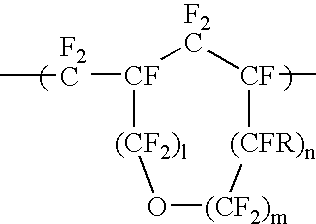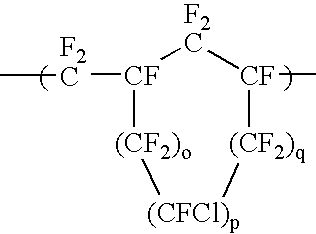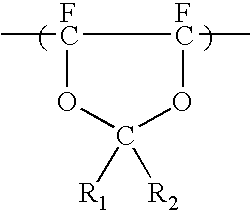Anti-reflective coating
- Summary
- Abstract
- Description
- Claims
- Application Information
AI Technical Summary
Benefits of technology
Problems solved by technology
Method used
Image
Examples
example 1
[0026] A 210 ml stainless steel shaker tube is chilled to below −20° C. and loaded with 2 g of EVE-OH dissolved in 50 ml of Vertrel® D XF, 24.4 g of PDD, and 10 ml of 0.17 M HFPO dimer peroxide in Vertrel XF. The tube is chilled again and 10 g of TFE is added. The tube is shaken overnight at room temperature reaching a maximum pressure of 51 psi at 13.4° C. and finishing about 18 hours later at 14.1 psi at 33.3° C. The resulting slightly-hazy, highly-viscous solution is blown down with N2, subjected to 30 hours of pump vacuum, and then finished for 10 days in a 67° C. vacuum oven with a slight N2 bleed. This generates 30.07 g of polymer, soluble in FC-40, with a composition of 51 mole percent of PDD, 48 mole percent of TFE, 1 mole percent of EVE-OH by fluorine NMR, and with an inherent viscosity of 0.333 in hexafluorobenzene. This polymer has Tg at about 106° C.
example 2
[0027] A 210 ml stainless steel shaker tube is chilled to below −20° C. and loaded with 2 g of EVE-P dissolved in 50 ml of Vertrel XF, 24.4 g of PDD, and 10 ml of 0.17 M HFPO dimer peroxide in Vertrel XF. The tube is chilled again and 10 g of TFE is added. The tube is shaken overnight at room temperature reaching a maximum pressure of 47 psi at 21.4° C. and finishing about 19 hours later at 6.8 psi at 34.1° C. The resulting hazy-white, highly-viscous mixture is blown down with N2, subjected to 30 hours of pump vacuum, and then finished for 10 days in a 67° C. vacuum oven with a slight N2 bleed. This generates 27.06 g of polymer, soluble in FC-40, with a composition of 47 mole percent of PDD, 52 mole percent of TFE, 1 mole percent of EVE-P by fluorine NMR, and with an inherent viscosity of 0.370 in hexafluorobenzene. This polymer has a Tg at about 101° C.
example 3
[0028] A round bottom flask equipped with a magnetic stir bar, a serum stopper, and a reflux condenser is flushed with N2 and then loaded with 100 ml of Vertrel XF, 12.8 ml of vinyl acetate, and 20 ml of PDD. The flask is then changed over from a nitrogen purge to a positive pressure of N2. Five milliliters of 0.17M HFPO dimer peroxide in Vertrel XF is injected through the serum stopper. Another 5 ml of 0.17 M HFPO dimer peroxide in Vertrel XF is injected after 23 hours. The reaction mixture is stirred for another 10 days at room temperature and then poured into 600 ml of methanol with stirring. The resulting sticky solids are vacuum filtered, washed with 100 ml of methanol, sucked damp dry on the paper filter overnight to get 41.39 g white chunks.
[0029] A round bottom flask equipped with a magnetic stir bar is loaded with 14.32 g of the copolymer made above and 114.6 g of methanol. The reaction mixture is stirred as 5.44 g of 45 wt % KOH are added dropwise. Much of the solid polym...
PUM
| Property | Measurement | Unit |
|---|---|---|
| Thickness | aaaaa | aaaaa |
| Adhesion strength | aaaaa | aaaaa |
Abstract
Description
Claims
Application Information
 Login to View More
Login to View More - R&D
- Intellectual Property
- Life Sciences
- Materials
- Tech Scout
- Unparalleled Data Quality
- Higher Quality Content
- 60% Fewer Hallucinations
Browse by: Latest US Patents, China's latest patents, Technical Efficacy Thesaurus, Application Domain, Technology Topic, Popular Technical Reports.
© 2025 PatSnap. All rights reserved.Legal|Privacy policy|Modern Slavery Act Transparency Statement|Sitemap|About US| Contact US: help@patsnap.com



